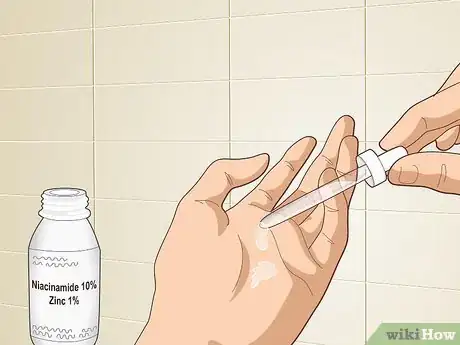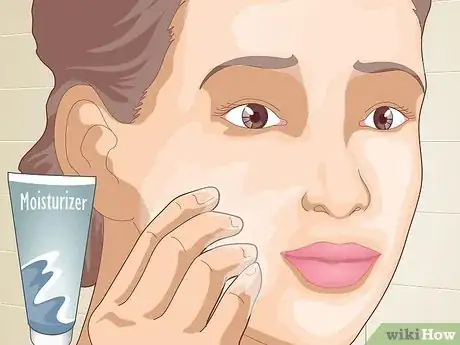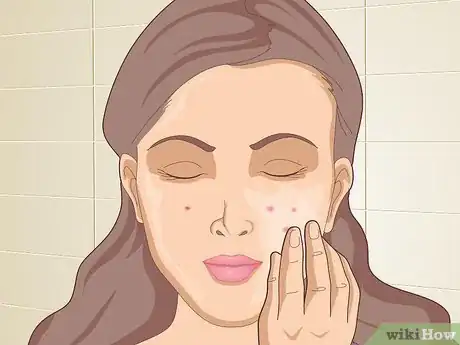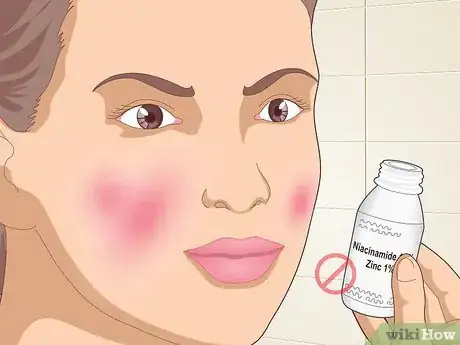This article was co-authored by Mohiba Tareen, MD and by wikiHow staff writer, Hannah Madden. Mohiba Tareen is a board certified Dermatologist and the founder of Tareen Dermatology located in Roseville, Maplewood and Faribault, Minnesota. Dr. Tareen completed medical school at the University of Michigan in Ann Arbor, where she was inducted into the prestigious Alpha Omega Alpha honor society. While a dermatology resident at Columbia University in New York City, she won the Conrad Stritzler award of the New York Dermatologic Society and was published in The New England Journal of Medicine. Dr. Tareen then completed a procedural fellowship which focused on dermatologic surgery, laser, and cosmetic dermatology.
This article has been viewed 201,263 times.
Niacinamide 10% Zinc 1% is a skincare product that can smooth out your skin, help with acne and rosacea, and improve your overall complexion.[1] Using it correctly is essential so that you get the most benefits out of this product. Niacinamide 10% Zinc 1% is great for almost every skin type, and you can incorporate it easily into your existing skin care routine for glowing, healthy skin in no time.
Things You Should Know
- Wash your face with a gentle cleanser and pat it dry before applying a couple of drops of Niacinamide 10% Zinc 1% to your skin.
- Apply heavy creams or other oil-based serums on top of the Niacinamide 10% Zinc 1%.
- Use Niacinamide 10% Zinc 1% if you have red, oily skin. Apply it twice a day, both morning and night, and avoid using vitamin C products simultaneously.
Steps
Incorporating Niacinamide 10% Zinc 1% into Your Routine
-
1
-
2Pat your skin dry with a towel. Grab a clean towel and gently pat it onto your skin to get all of the water off. Try to avoid rubbing or scrubbing your skin, as that can cause dryness and irritation.[4]
- Make sure the towel you use is clean, or else you’ll just be rubbing dirt and oils back into your skin.
Advertisement -
3Drop 2 drops of Niacinamide 10% Zinc 1% in your hands. Unscrew the dropper from the bottle of Niacinamide 10% Zinc 1% and use it to drop 2 drops into the palm of your hands. Rub the product in your palms slightly to spread it around before you start applying.[5]
- If you use too much of the product, you could cause irritation, especially if you have sensitive skin.
-
4Rub the serum all over your skin. Use your palms to spread the serum all over your face. Make sure you get your forehead, nose, chin, and cheeks for an even coverage. The serum will start to dry almost instantly, so you won’t see it build up on your skin.
- Avoid the thin skin under and around your eyes, as Niacinamide 10% Zinc 1% is a little too strong for that area.
- Niacinamide 10% Zinc 1% is water-based, so it should always be first in your skincare routine.
-
5Rub on any oil-based serums in your skincare routine. If you have any oil-based products that you use, like vitamin E oil, you can rub them on now. Make sure you use the oil-based products after the Niacinamide 10% Zinc 1% to avoid clogging your pores.
- Oil-based serums penetrate deep into your skin, keeping it moisturized and hydrated.
-
6Apply any heavy creams that you use on top of it. To finish your routine, you can put on heavy cream products, like moisturizers.[6] Rub that into your skin on top of the Niacinamide 10% Zinc 1% and any oil-based serum that you used.
- Always save any heavy creams for last, because they take the longest to soak into your skin.
Knowing When to Use Niacinamide 10% Zinc 1%
-
1Apply Niacinamide 10% Zinc 1% both morning and night. You can use this product as often as you’d like to because it’s so mild. You don’t need to worry about alternating it, and you can use it whenever you do your normal skin care routine.
- If you start using Niacinamide 10% Zinc 1% day and night, you’ll most likely notice a difference in your skin within 1 week.
-
2Use Niacinamide 10% Zinc 1% if you have red, oily skin. Niacinamide 10% Zinc 1% is a calming and soothing product that can help reduce the size of your pores and even out your skin tone. It can also reduce the appearance of any marks left over from blemishes on your skin, like red or brown dots.[7]
- If you suffer from acne, Niacinamide 10% Zinc 1% might not be the best product for you. While it can reduce the appearance of redness in your skin, it won’t get rid of blemishes.
-
3Avoid using vitamin C products with Niacinamide 10% Zinc 1%. The one product that Niacinamide 10% Zinc 1% doesn’t work well with is vitamin C. Although they won’t cause an adverse reaction, vitamin C can counteract the effects of niacinamide, making the product not as effective. If you do use any products that contain vitamin C in your skincare routine, alternate them with Niacinamide 10% Zinc 1%.
- For example, if you use Niacinamide 10% Zinc 1% in the morning, apply your vitamin C product at night.
-
4Stop using Niacinamide 10% Zinc 1% if your skin gets irritated. Although Niacinamide 10 Zinc 1 works for most skin types, there is a chance that it can cause irritation. If you notice your skin getting red or itchy, stop using the product right away and talk to a medical professional.
- Redness or itchiness could indicate an allergic reaction.
Warnings
- Stop using Niacinamide 10% Zinc 1% if your skin gets red or itchy, as it could be an allergic reaction.⧼thumbs_response⧽
References
- ↑ https://pubmed.ncbi.nlm.nih.gov/17147561/
- ↑ Mohiba Tareen, MD. FAAD Board Certified Dermatologist. Expert Interview. 26 March 2020.
- ↑ https://www.youtube.com/watch?v=iWF2GXxJz5c&feature=youtu.be&t=40
- ↑ https://www.youtube.com/watch?v=iWF2GXxJz5c&feature=youtu.be&t=40
- ↑ https://www.youtube.com/watch?v=iWF2GXxJz5c&feature=youtu.be&t=83
- ↑ Mohiba Tareen, MD. FAAD Board Certified Dermatologist. Expert Interview. 26 March 2020.
- ↑ https://www.youtube.com/watch?v=6PCzGu52uEA&feature=youtu.be&t=96
- ↑ Mohiba Tareen, MD. FAAD Board Certified Dermatologist. Expert Interview. 26 March 2020.































































